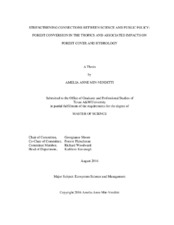| dc.description.abstract | Despite the prevailing assumption that hydrological flow variation is amplified and runoff increased with deforestation, evidence behind these claims is limited for very moist tropical regions. Data derived from field observations are needed to productively manage forested watersheds, optimize global climate models, and inform policymaking. First, I used a case study from mature forest and crop fields in Costa Rica to improve understanding of hydrological effects of forest conversion in tropical forests. Furthermore, I conducted a systematic review of the impact of public policies on forest cover in Mesoamerica.
Examining micrometeorological differences between mature forest and cropland, leaf wetness duration (LWD) was 5 times longer in the forest. Within crop species, papaya dried significantly slower than the shorter taro and sweet potato. Average daily evapotranspiration (ETcrop) as calculated by the FAO56 modified Penman-Monteith crop coefficient method was 2.75 mm for forest compared to crop values for papaya (1.83), taro (1.76), and sweet potato (1.43). These results suggest the possibility of higher runoff and alteration of rainfall recycling in the humid tropics following forest conversion to cropland. Canopy height and LWD seemed to be good indicators of differences in ETcrop.
In order to successfully protect forests, the public policy type most likely to result in positive effects was market-based conservation, as zero cases were linked to increased deforestation or decreased forest cover. 81% of the community based management policy cases and 66% of the protected areas cases were positive. 83% of the agricultural policy cases resulted in more deforestation.
In order to increase effectiveness of forest conservation strategies, scientific reporting, such as this study, contributes knowledge to help inform policy. It can be inferred that longer LWD is associated with higher evapotranspiration of intercepted rainfall and lower runoff ratios in tropical forests compared to croplands. Therefore future policy directed at hydrological services should consider estimates of runoff from agricultural conversion in their decision-making process and target watersheds with high flood hazard potentials associated with large-scale deforestation. | en |


